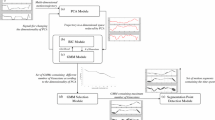Abstract
Proposed is a new approach to task segmentation in a mobile robot by a modular network SOM (mnSOM). In a mobile robot the standard mnSOM is not applicable as it is, because it is based on the assumption that class labels are known a priori. In a mobile robot, only a sequence of data without segmentation is available. Hence, we propose to decompose it into many subsequences, supposing that a class label does not change within a subsequence. Accordingly, training of mnSOM is done for each subsequence in contrast to that for each class in the standard mnSOM. The resulting mnSOM demonstrates good segmentation performance of 94.05% for a novel dataset.










Similar content being viewed by others
References
Aziz Muslim M, Ishikawa M, Furukawa T (2006) A new approach to task segmentation in mobile robots by mnSOM. In: Proceedings of 2006 IEEE world congress on computational intelligence (IJCNN2006 Section), Vancouver, Canada, pp 6542–6549
Furukawa T, Tokunaga K, Kaneko S, Kimotsuki K, Yasui S (2004) Generalized self-organizing maps (mnSOM) for dealing with dynamical systems. In: Proceedings of 2004 international symposium on nonlinear theory and its application (NOLTA2004), Fukuoka, Japan, pp 231–234
Furukawa T, Tokunaga K, Morishita K, Yasui S (2005) Modular network SOM (mnSOM): from vector space to function space. In: Proceedings of IJCNN2005, Canada
Jacobs R, Jordan M, Nowlan S, Hinton G (1991) Adaptive Mixtures of Local Experts. Neural Computation 3:79–87
Kohonen T (1995) Self-organizing maps. Springer, Heidelberg
Martinetz T (1993) Neural-gas network for vector quantization and its application to time-series prediction. IEEE Trans Neural Netw 4(4):558–569
Nolfi S, Tani J (1999) Extracting regularities in space and time through a cascade of prediction networks: the case of a mobile robot navigating in a structural environtment. Connect Sci (11)2:129–152
Tani J (1996) Model-based learning for mobile robot navigation from dynamical system perspective. IEEE Trans Syst Man Cybern Part B 26(3):421–436
Tani J, Nolfi S (1999) Learning to perceive the world as articulated: an approach for hierarchical learning in sensory-motor systems. Neural Netw 12:1131–1141
Tani J, Ito M, Sugita Y (2004) Self-organization of distributedly represented multiple behavior schemata in a mirror system: reviews of robot experiments using RNNPB. Neural Netw 17:1273–1289
Tokunaga K, Furukawa T, Yasui S (2003) Modular network SOM: extension of SOM to the realm of function space. In: Proceedings of workshop on self-organizing maps (WSOM2003), pp 173–178
Walter JA, Schulten KJ (1993) Implementation of self-organizing neural networks for visuo-motor control of an industrial robot. IEEE Trans Neural Netw 4(1):86–95
Williams RJ, Zipser D (1992) Gradient-based learning algorithms for recurrent networks and their computational complexity. In: Chauvin Y, Rumelhart D (eds) Backpropagation: theory, architectures and applications. Erlbaum, Hillsdale, pp 433–486
Wolpert DM, Kawato M (1998) Multiple paired forward and inverse models for motor control. Neural Netw 11:1317–1329
Acknowledgments
This research was partially supported by the 21st Century COE (Center of Excellence) Program and by Grant-in-Aid for Scientific Research (C) (18500175) both from the Ministry of Education, Culture, Sports, Science and Technology(MEXT), Japan.
Author information
Authors and Affiliations
Corresponding author
Rights and permissions
About this article
Cite this article
Aziz Muslim, M., Ishikawa, M. & Furukawa, T. Task segmentation in a mobile robot by mnSOM: a new approach to training expert modules. Neural Comput & Applic 16, 571–580 (2007). https://doi.org/10.1007/s00521-007-0109-7
Received:
Accepted:
Published:
Issue Date:
DOI: https://doi.org/10.1007/s00521-007-0109-7




